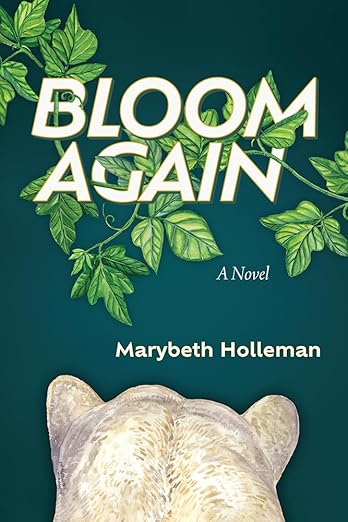University of Alaska Press, 2025

Edward O. Wilson, a pioneer of evolutionary biology, once wrote, “Humanities will have to blend with the sciences, because technology is going to demand the self-understanding of our species.” The search for self-understanding, personally and professionally, is the driving force of Bloom Again, a beautifully written debut novel by Marybeth Holleman, in which two women, an artist and a scientist, grapple with their lives in a warming world. With the urgency of a true crime narrative, Holleman plumbs their emotional depths as they struggle with mid-life crises, while managing to walk the reader through the global complexity of climate issues. It’s time for many things to change.
The novel opens with Elyse, an artist in Alaska, who is trying to prioritize her creative life but hardly knows where to start. Her husband works for Doctors Without Borders and when he’s not traveling, he’s arguing with her. Elyse teaches in the artist-in-the-school program and gets pulled into being a chaperone to the zoo, which she dreads. “She’s read that zoo animals have smaller brains than their wild counterparts; they don’t need much knowledge to survive in a zoo.” She’d been drawn to Alaska for the wildlife, so the sight of sad, imprisoned Binky, the zoo’s polar bear, is a jolt. After coming across a “no ice equals no bears” article, she begins to obsess over polar bears, and at the same time, she starts dreaming of kudzu, a plant from her native North Carolina.
Living in that mid-Atlantic state is Astrid, a tenured paleobotanist professor at Chapel Hill, who is being pressured to accept a grant funded by ExxonMobil. Astrid feels she’s made a wrong turn in life and is not sure how or when that happened. “She wants to make evolution come alive, she wants to smell the forests of her fossils,” and yet she’s her own worst enemy. She alienates her mentor at an academic climate event when she says it’s too late to save the polar bears, that the ice pack is going and so are they.
For both women, opportunities arise to change their lives, and they grab for the rings, but not without a great deal of second-guessing and conflicting emotions. After Elyse attends a talk hosted by the Wildlife Protection Organization, where scientists discuss the effects of shrinking ice due to climate change, she applies for an artist residency on their next expedition to Churchill, Manitoba in Canada. When she is accepted, her husband is totally against it, but she is firm. “A warming planet is easy to ignore. Until it isn’t.” In Churchill she sees for herself that because the bay is not icing over, the bears can’t hunt and are dying unnatural deaths, as are the walrus cubs who are caught in walrus stampedes caused by both bears and tourists. As dismal as it it, she begins to find what she needs to fuel her art.
During this time, Astrid is struggling with her career choices in a world where research is now funded by corporations. She, too, goes to Churchill, but only to help her mentor get home after a heart attack. He had gone to study the bears, but she is mostly unmoved by their plight. It is not until he convinces her to help with a months-long afforestation project in India in the name of climate remediation, that she begins to feel the change she has been yearning for. At first, she is disgusted by much of what she sees in India, including the sacred cows dying of ingested plastics, but after time with her hands in the dirt, she reconnects with her younger self. She remembers how her mother took in rejected plants and made them “bloom again,” words that could now apply both to her and Elyse.
Eventually the two women meet up in what turns out to be a reunion, but there is no sugar-coating here, or anywhere in Bloom Again. Life is complicated, decisions are often fraught, and change seems impossible. Despair is a frequent visitor when it comes to the climate crisis, where setbacks and disappointments are commonplace. But in spite of it all, these two seemingly different women come to the same conclusion: Art and science are not so separated after all, and plants can save us and the world if we let them.
JoeAnn Hart writes about the pervasive and widespread effects of the climate crisis on the natural world and the human psyche. Her most recent book, Arroyo Circle, a story of reclamation in a time of loss, was released by Green Writers Press in 2024. Her other books include the prize-winning environmental and animal fiction collection Highwire Act & Other Tales of Survival, the crime memoir Stamford ’76: A True Story of Murder, Corruption, Race, and Feminism in the 1970s, as well as Float, a dark comedy about plastics in the ocean published by Ashland Creek Press, and Addled, a social satire. She is a regular reviewer of climate and animal fiction at EcoLit Books.
